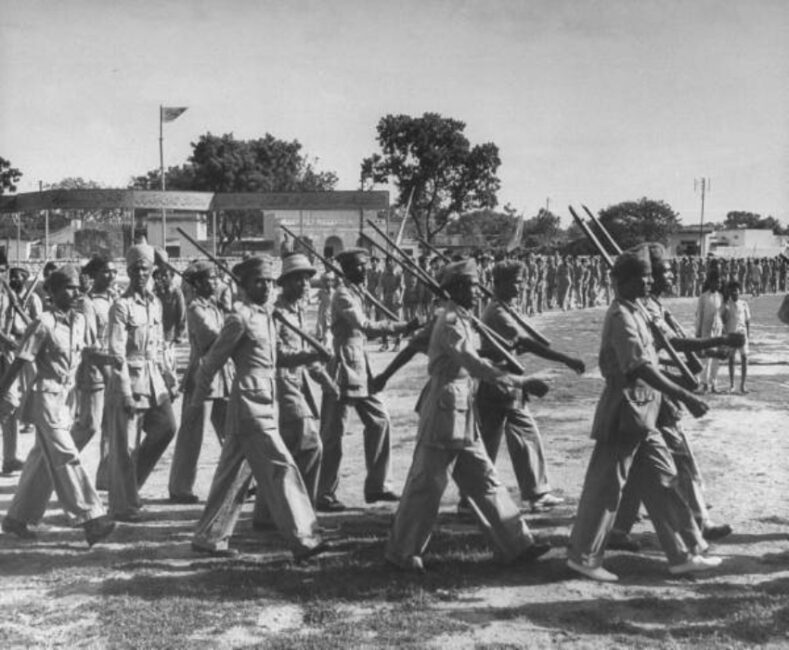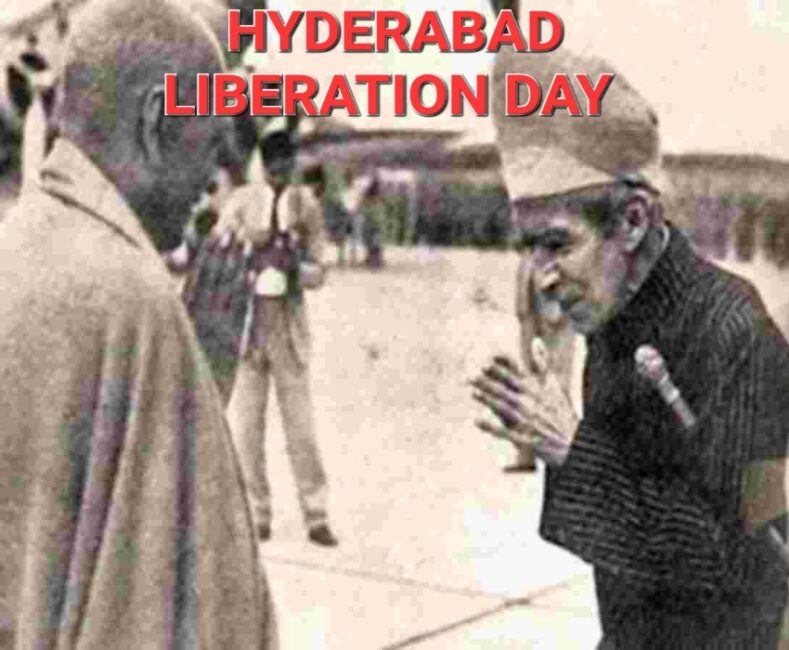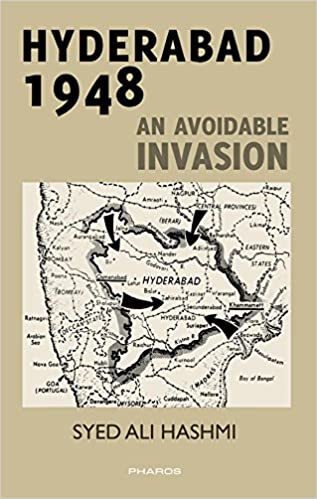Every time, Hyderabad’s political climate heats up in the month of September. The million-dollar question—was Hyderabad freed or merged? — creates a stir. The controversy is unending, much like the question of which came first, the egg or the chicken. Additionally, disagreements tend to inflame emotions.

September 17 has developed into a political brawl as of late. Some people want to commemorate it as “Liberation Day,” others as “Merger Day,” and only a select minority as “Betrayal Day.” It is also known as the day of the covert police operation known as “Operation Polo.” Whatever the case, it continues to be the most contentious episode in Indian history.
However, many believe it is incorrect to refer to the invasion of Hyderabad as a “Police Action.” The moniker is intended to give the attack the appearance of being a police and order issue. According to Syed Ali Hashmi, author of the book Hyderabad 1948: An Avoidable Invasion, “It was an organised, pre-planned full-blown military operation in which the air force attacked objectives followed by tanks, armoured cars, and armed men.”
Much before the Police Action, Hyderabad state saw a severe economic blockade. Supply of petrol and crude oil was stopped to paralyse communication and transportation. The blockade was similar to the economic sanctions imposed by UN on Iraq when Saddam Hussein was the ruler. These measures were intended to force the Nizam to ‘kneel down’ before the Indian Union. There was also an arms embargo following reports of the Nizam clandestinely importing weapons from abroad. There was also propaganda about Muslim countries coming to the rescue of Hyderabad but in reality nothing of that sort happened.
The last princely state to accede to Indian Union, many nationalists felt the existence of independent Hyderabad constituted a dangerous portent for the independence of India itself. The tragedy of Hyderabad, according to renowned lawyer, A.G. Noorani, was only fait accompli once the British rule in the Indian sub-continent ended on August 15, 1947. “Only statesmanship could have averted it, but it was in short supply at that time,” he writes in his book – The Destruction of Hyderabad.
The feudal order of the Nizam had to go. But the violent way the transition to democracy was made was more painful with lasting consequences. Nehru had contempt for the Nizam’s set up, but he bore no malice towards him personally while Sardar Patel hated the Nizam personally and ideologically opposed Hyderabad’s composite culture. “Nehru wanted to avoid India’s balkanisation by defeating Hyderabad’s secessionist venture. But Patel wanted to go further. He wanted to destroy Hyderabad and its culture completely,” says Noorani.
In the run up to D-day, Nizam made desperate attempts to stop the invasion. He wrote a personal letter to C. Rajagopalachary, the then Governor General, to use his good offices and see that good sense prevailed. There were reports of the militant Razakars taking the administration into their hands and creating lawlessness. Having drawn a blank from all sides, the Nizam felt betrayed by the British Crown.
Many believe the Nizam did the right thing in surrendering to the Indian military as the latter was far superior in terms of numbers and weaponry. The Indian Army commenced its actions on September 13 from all sides. In the end the Hyderabad state surrendered meekly to the Indian military without a single shot being fired. This was largely due to the betrayal of El Edroos, the Commander-in-Chief of the Hyderabad Army, who instructed the various army sector commanders to ‘avoid resistance and surrender.’

Though the Nizam was far outnumbered in military might, his army could still have fought and resisted the Indian forces at least for sometime as a matter of prestige. But Nizam was unaware of the conspiracy hatched by Edroos and his secret orders to the Hyderabad Army not to resist the Indian Army, it is said.
The military strength of Hyderabad at the time of Police Action was just a fighting force of 22,000. It had guns, three armored regiments while one fourth of the irregular army was equipped with modern weapons and the rest were armed with muzzle loaders. This apart there were 10,000 armed Arabs, 10,000 Razakars and soldiers of Paigah and jagir police. Historian, M.A. Nayeem, calls the Indian invasion as ‘naked aggression’ and in ‘blatant violation’ of international law. The military attack was euphemistically named ‘Operation Polo’ to assuage the world criticism of the unprovoked aggression, he says.
Whatever, the Asaf Jahi dynasty which ruled the Deccan for nearly 224 years, ended on September 17, 1948 with the Nizam signing an instrument of accession to join India.
Now the Union government has decided to hold a year long commemoration to mark 75 years of ‘Hyderabad State Liberation’. This is seen as an attempt to give the historic reality a religious colour while ‘Betrayal Day’ gets support from the fact that it was a breach of the Standstill Agreement. The TRS government is gearing up to observe the event as “Telangana National Integration Day”. In whatever fashion the day is observed it is bound to revive painful memories and reopen old wounds.
On the other hand, the political scenario changed On September 17, Hyderabad Liberation Day Or Telangana National Integration Day? Which becomes the talk of the town as the political heat raises day by day in the state of Telangana.
BJP’s narrative with regard to the Liberation Day has communal overtones, amid allegations that KCR has so far remained passive on the matter due to his cosy relationship with the AIMIM and Hyderabad MP Asaduddin Owaisi.
The historical significance of the date September 17, the day on which the erstwhile princely state of Hyderabad became part of the Union of India 74 years ago, seems to be the latest tool in the Bharatiya Janata Party (BJP)’s arsenal to gain ground in Telangana. With the Assembly elections in the southern state just a year away, the BJP-led Union government had recently announced its decision to hold year-long celebrations of the ‘Hyderabad Liberation Day’ to mark 75 years of the Hyderabad state’s annexation to India.
It may be noted that the BJP or its ideological ancestors, however, had no role in the events that led to the annexation of Hyderabad during the regime of Nizam Osman Ali Khan through ‘Operation Polo’, a military action conducted by the Indian Army a year after Independence. Rather, BJP’s narrative with regard to the ‘Liberation Day’ has communal overtones, amid allegations that KCR has so far remained passive on the matter due to his cosy relationship with the All India Majlis-E-Ittehadul Muslimeen (AIMIM) and Hyderabad MP Asaduddin Owaisi.
KCR’s move to counter the BJP’s propaganda machinery is to celebrate September 17 as the ‘Telangana National Integration Day’ instead. The decision comes in tow of a letter written by Owaisi to Union Home Minister Amit Shah and the Telangana Chief Minister, urging both the Union and state governments to celebrate the day as such. In his letter, Owaisi had said that the common Hindus and Muslims of erstwhile Hyderabad state were advocates of a united India under a democratic, secular and republican government.
The same was reflected in the Sunderlal Committee report as well, he pointed out in the letter. “The struggles of the people of the erstwhile Hyderabad state against colonialism,feudalism and autocracy are a symbol of national integration rather than merely a case of ‘liberation’ of a piece of land or the removal of a ruler,” he added.
Owaisi’s letter had come as a convenient tool for KCR to plot against the BJP’s decision to celebrate the ‘Liberation Day’, with the CM soon announcing the decision to commemorate September 17 as ‘National Integration Day’.
But it may already be too late, political observers feel, as adequate damage has already been done by the BJP propaganda machinery. In fact, BJP’s Telangana State President Bandi Sanjay has claimed that the party saw KCR’s decision as the BJP’s victory, while accusing the CM of distorting the history of the liberation of Hyderabad and seeking approval from the Darussalam, the AIMIM headquarters.
Besides, KCR himself had demanded the celebration of a Liberation Day while he was leading the Telangana statehood movement, which the BJP is now capitalising on.
According to Palwai Raghavendra Reddy, a Hyderabad-based political analyst, KCR’s decision to celebrate September 17 as Telangana National Integration Day might help blunt the BJP’s efforts to tilt the communal narrative around the date, but it cannot contain the damage that has already been done. “Until 2018, KCR used to set the narrative in Telangana. But it seems like he is falling behind now. Currently, he is paying the cost for his consistently passive attitude towards the commemoration of September 17,” he said.
Raghavendra further noted that KCR’s delayed push for ‘Telangana National Integrity Day’ may merely help him retain some control, as the major fruit in this tussle would be yielded by the BJP.
Before leaving the country in 1947, the British had given princely states such as Hyderabad two choices — either accede to the newly born dominions of India or Pakistan, or continue as an independent sovereign state. In India, under the leadership of the country’s first Prime Minister Jawaharlal Nehru, Home Minister Sardar Vallabhai Patel was tasked with the responsibility of overseeing the merger of princely states.
During the same period, the Nizam regime in Hyderabad was witnessing the Telangana Peasants Armed Rebellion led by the Communist Party of India (CPI) against the Doras, the caste Hindu landlords, and the Muslim elite who held dominance over the land. The peasants of lower castes were subjected to oppression by the state-appointed Jagirdars in the name of tax collection. In addition, the Razakars of Majlis E Ittehadul Muslimeen (MIM), a fundamentalist paramilitary force led by Khasim Razvi, was also unleashing violence and atrocities on the peasants.

According to several historians, the chieftains (Rajas) and landlords under the Nizam aegis were mostly caste Hindus, who held control over the maximum share of revenue lands (diwani). Different historical accounts suggest that caste Hindus have enjoyed significant patronisation from the side of the government as well, besides being allotted powers on land and revenue on par with Muslim elite.
At the time, the Nizam’s decision to retain Hyderabad as an independent state was opposed by the Indian government, in the wake of which the Indian Military’s Operation Polo was launched. The military action is said to have resulted in the killings of 27,000 to 40,000 Muslims, following which the last Nizam annexed the state to India on September 17, 1948. Later, he was given the title of the Raj Pramukh, a position equivalent to that of the Governor, by the Indian government. Meanwhile, Razvi was jailed for a decade before he was allowed to leave for Pakistan. #Khabarlive #hydnews #hyderabadlive
